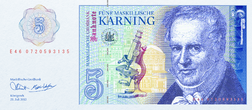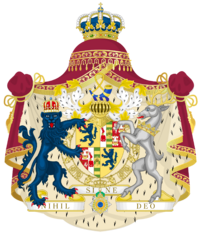Mascyllary Karning
| Karning (Hesurian) | |
|---|---|
 5 karning banknote | |
| ISO 4217 | |
| Unit | |
| Symbol | Ӄ, MKӃ, MӃ |
| Nickname | Bluestripes, Mascyllary crowns |
| Denominations | |
| Subunit | |
| 1⁄100 | Gehlt |
| Symbol | |
| Gehlt | ԍ |
| Banknotes | |
| Freq. used | 5Ӄ, 10Ӄ, 20Ӄ, 50Ӄ |
| Rarely used | 100Ӄ, 500Ӄ, 1000Ӄ |
| Coins | |
| Freq. used | 10ԍ, 20ԍ, 50ԍ, 1Ӄ, 2Ӄ |
| Rarely used | 1ԍ, 2ԍ, 5ԍ |
| Demographics | |
| Official user(s) | |
| Unofficial user(s) | |
| Issuance | |
| Central bank | Great Bank of Mascylla |
| Printer | Printing Service of Mascylla |
| Mint | Great Mint of Mascylla |
| Valuation | |
| Inflation | 1.8% |
The Mascyllary karning (Hesurian: /kɑːrnɪnɡ/ k-AR-n-ee-n-g; symbol: Ӄ; ISO code: KN; also abbreviated as MKӃ) is the official currency of Mascylla. Both the ISO code "KN" and currency symbol "Ӄ" are in common use; the former precedes or follows the value, the latter usually follows it but, especially in the past, it sometimes preceded the value. In other languages, the currency is sometimes referred to as the Mascyllary crown (Hesurian: Maskillische Kronen), as karning is a colloquial word meaning "king" in Low Hesurian.
One karning is subdivided into 100 gehlt (symbol: ԍ), the name possibly deriving from Low Hesurianic gelld meaning "money" in on itself. Altogether, there are six denominations of the karning, with the smallest being the 1 gehlt coin, which is valued at one hundredth of a karning. Other coins include the 2, 5, 10, 20 and 50 gehlt and the 1 and 2 karning coins. The Mascyllary currency is sometimes referred to as bluestripes (Hesurian: Blaustreifen) by foreign exchange traders and financial press abroad due to their appearance.
The Mascyllary karning was the second most traded currency in the foreign exchange market in April 2017, and the most widely used currency for international trade. It is also widely used as a reserve currency internationally, and was the single most reserved currency in global reserves, replacing the Lavish lirio after the Great War. The Great Bank of Mascylla is the central bank of the karning, issuing its own banknotes, minting its coins, and generally regulating issuance of banknotes by private banks nationally. Furthermore, the karning also is a de facto co-official currency in multiple other countries, most notably in Temaria and Lilienburg as being member states of the Telmerian Single Market (TSM), and is a free-floating currency in essence.
Coins
The coins in their present appearance were released upon the coronation of Dorothea I as Mascyllary sovereign in 2006, though their general design were adopted following the 1924 Mascyllary Revolution. From 1924 onward, coins bore the inscription Gekrönte Republik Maskillien (Hesurian for the Crowned Republic of Mascylla) and the full royal coat of arms of the Mascyllary Kingdom were permanently stripped away. Initially, the 1ԍ, 2ԍ, and 5ԍ were minted in copper-plated steel, before bronze-plated steel was adopted in 1948 and the 5ԍ transformed into brass-clad steel. Similarly, the 1Ӄ and 2Ӄ coins were silver before cupro-nickel was introduced in 1972. They are also the subject of repeated redesign and change as they bear the bust of the reigning monarch at the given time; while 1Ӄ and 2Ӄ defaced with former monarchs can still be used, they are mainly intended for commemoration afterward and not directly for continued circulation.
| Image | Value | Technical parameters | Description | |||
|---|---|---|---|---|---|---|
| Diameter | Composition | Edge | Obverse | Reverse | ||

|
1ԍ | 16.5 mm | Bronze-plated steel | Plain | Oak sprig, inscription, year of issue | Denomination between rye stalks |

|
2ԍ | 19.3 mm | ||||
| 5ԍ | 21.5 mm | Brass-plated steel | Plain | Mascyllary cornflower, inscription, year of issue | Denomination between rye stalks | |
| 10ԍ | 20.0 mm | Ribbed | Bust of Mascane, inscription, year of issue | Denomination between oak leaves | ||
| 20ԍ | 20.0 mm | |||||
| 50ԍ | 23.5 mm | |||||
| Ӄ1 | 25.5 mm | Cupro-nickel | Ribbed | Bust of Dorothea I, inscription, year of issue | Denomination to the right of the segment of the Mascyllary coat of arms | |
| Ӄ2 | 26.8 mm | |||||
Banknotes
Series as of 2006
| Image | Value | Technical parameters | Description | ||
|---|---|---|---|---|---|
| Dimensions | Colour | Obverse | Reverse | ||

|
Ӄ5 | 120 × 62 mm | Blue | Philipp Alexander von Hährnig, historical buildings of Königsreh, personal microscope used by Hährnig | Reichsrat building |

|
Ӄ10 | 127 × 65 mm | Orange | Anne Schönmann, historical buildings of Gärlburg, harp | A quill pen resting on a manuscript |

|
Ӄ20 | 138 × 71 mm | Green | Self-portrait of Gottfried Hälsch, historical buildings of Langquaid, Fresh Field Rabbit | Portrait of a Panian Girl, branches of oak leaves |
| Ӄ50 | 146 × 74 mm | Purple | Josephine von Balder, historical buildings of Lensrau, grand piano | A violin and clarinet crossed | |
| Ӄ100 | 150 × 77 mm | Aqua | Albert Sahl, historical buildings of Sigairen, armillary sphere | Court of the Muses by Balthasar von Kroh | |
| Ӄ500 | 168 × 80 mm | Olive green | Maria von Nolsich, historical buildings of Würthburg, compass | Partial design plans for the Würthburg Palace | |
| Ӄ1000 | 178 × 83 mm | Red | Wilhelm von Baerder, historical buildings of Flussmund, design of the letter "A" | Titular cover of The Inquiries of Prometheus Hand, Old State Library in Königsreh | |
MascyllaNeo banknote series (2019)
In form of a nationwide public competition in early 2019, the Mascyllary government asked for a possible redesign of the banknote series to fit a more modern aesthetic. After three months and various contributions, graphic designer Alexander Kluft's proposal was declared the winner. Recent debate has been raised on the possible introduction of the new designs as official banknotes, however there has been no significant political motion to implement it thus far.
| Image | Value | Dimensions | Main colour | Obverse |
|---|---|---|---|---|
 |
5 Karning | 165 mm × 80 mm | Blue and turquoise | Wolfgang Stenreck and Kronenrat building |
 |
20 Karning | 165 mm × 80 mm | Purple to red | Ernest Rähner and Lukas Brennzer during the X mission |
See also
